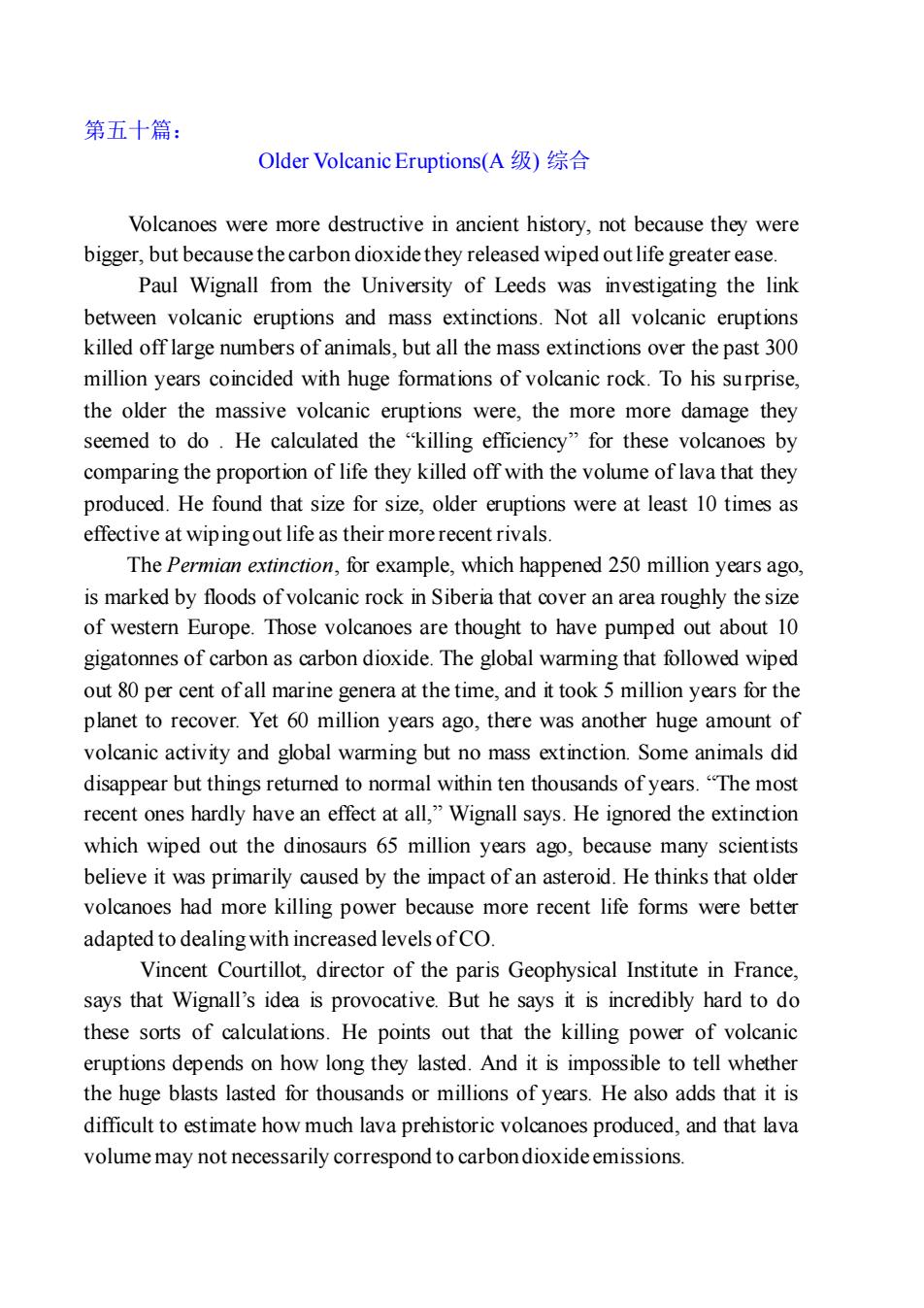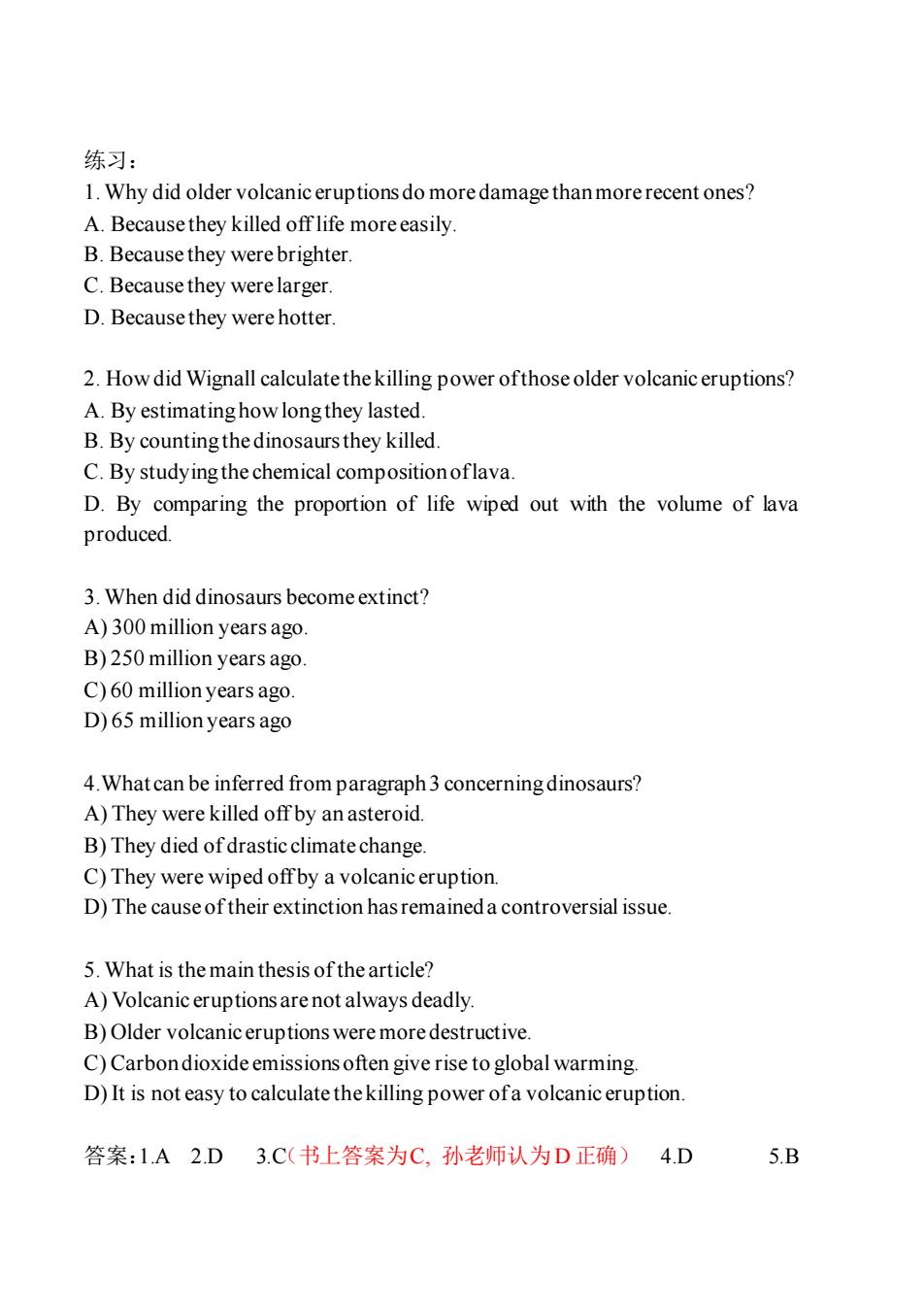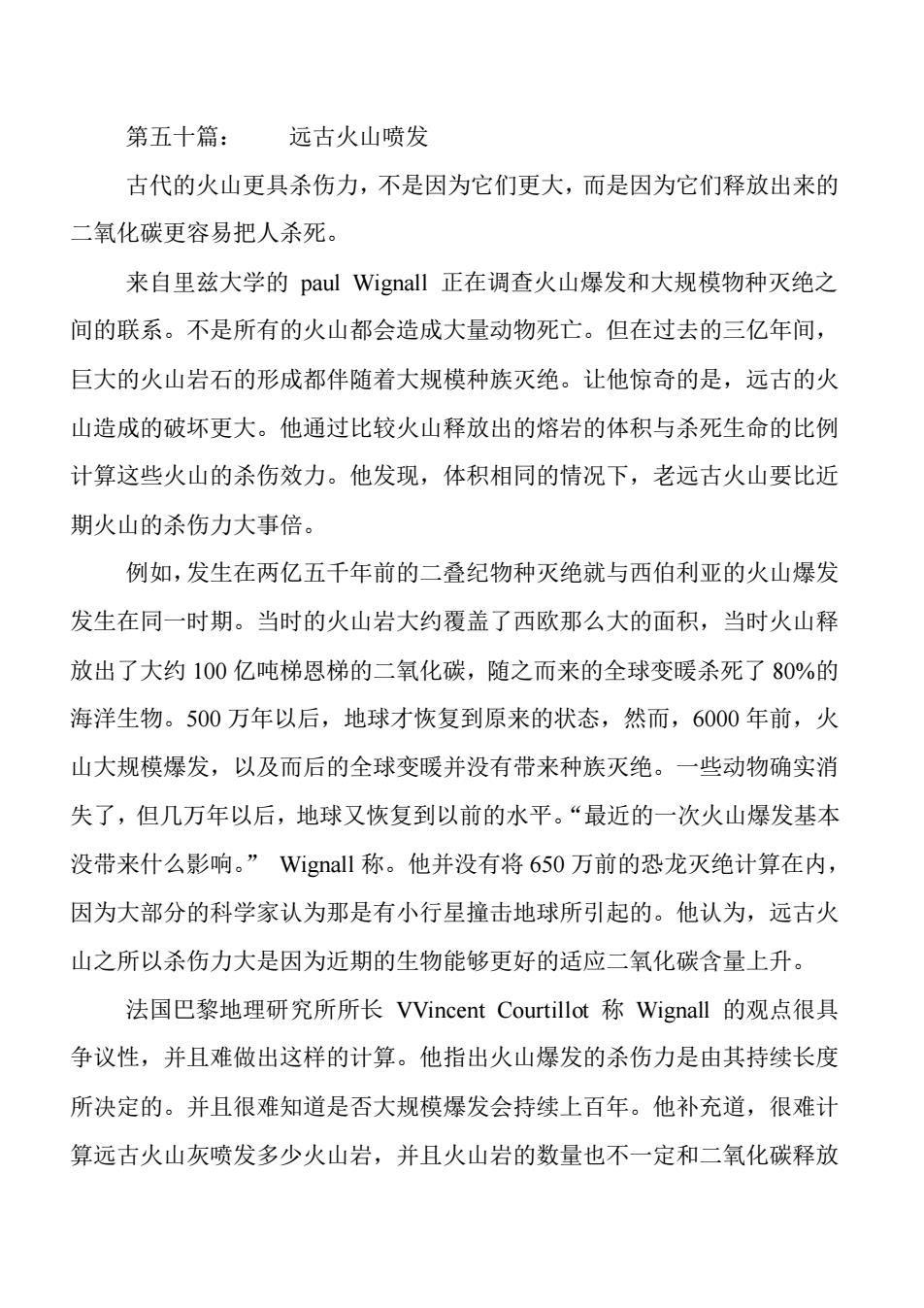
第五十篇:OlderVolcanicEruptions(A级)综合Volcanoes were more destructive in ancient history, not because they werebigger, butbecausethe carbon dioxidetheyreleased wiped out lifegreater easePaul Wignall from the University of Leeds was investigating the linkbetween volcanic eruptions and mass extinctions. Not all volcanic eruptionskilled off large numbers of animals, but all the mass extinctions over the past 300million years coincided with huge formations of volcanic rock. To his surprise,theolder themassivevolcanic eruptions were,the more more damage theyseemed to do .He calculated the“killing efficiency"for these volcanoes bycomparing the proportion of life they killed off with the volume of lava that theyproduced. He found that size for size, older eruptions were at least 10 times aseffective at wiping out life as their morerecentrivals.The Permian extinction, for example, which happened 250 million years ago,is marked by floods of volcanic rock in Siberia that cover an area roughly the sizeof western Europe. Those volcanoes are thought to have pumped out about 10gigatonnes of carbon as carbon dioxide. The global warming that followed wipedout 80 per cent of all marine genera at the time, and it took 5 million years for theplanet to recover. Yet 60 million years ago, there was another huge amount ofvolcanic activity and global warming but no mass extinction. Some animals diddisappear but things returned to normal within ten thousands of years. “The mostrecent ones hardly have an effect at all," Wignall says. He ignored the extinctionwhich wiped out the dinosaurs 65 million years ago, because many scientistsbelieve it was primarily caused by the impact of an asteroid. He thinks that oldervolcanoes had more killing power because more recent life forms were betteradapted to dealing with increased levels ofco.Vincent Courtillot, director of the paris Geophysical Institute in Francesays that Wignall's idea is provocative. But he says it is incredibly hard to dothese sorts of calculations. He points out that the killing power of volcaniceruptions depends on how long they lasted. And it is impossible to tell whetherthe huge blasts lasted for thousands or millions of years. He also adds that it isdifficultto estimatehowmuchlavaprehistoricvolcanoesproduced,and that lavavolume may not necessarily correspond to carbon dioxide emissions
第五十篇: Older Volcanic Eruptions(A 级) 综合 Volcanoes were more destructive in ancient history, not because they were bigger, but because the carbon dioxide they released wiped out life greater ease. Paul Wignall from the University of Leeds was investigating the link between volcanic eruptions and mass extinctions. Not all volcanic eruptions killed off large numbers of animals, but all the mass extinctions over the past 300 million years coincided with huge formations of volcanic rock. To his surprise, the older the massive volcanic eruptions were, the more more damage they seemed to do . He calculated the “killing efficiency” for these volcanoes by comparing the proportion of life they killed off with the volume of lava that they produced. He found that size for size, older eruptions were at least 10 times as effective at wiping out life as their more recent rivals. The Permian extinction, for example, which happened 250 million years ago, is marked by floods of volcanic rock in Siberia that cover an area roughly the size of western Europe. Those volcanoes are thought to have pumped out about 10 gigatonnes of carbon as carbon dioxide. The global warming that followed wiped out 80 per cent of all marine genera at the time, and it took 5 million years for the planet to recover. Yet 60 million years ago, there was another huge amount of volcanic activity and global warming but no mass extinction. Some animals did disappear but things returned to normal within ten thousands of years. “The most recent ones hardly have an effect at all,” Wignall says. He ignored the extinction which wiped out the dinosaurs 65 million years ago, because many scientists believe it was primarily caused by the impact of an asteroid. He thinks that older volcanoes had more killing power because more recent life forms were better adapted to dealing with increased levels of CO. Vincent Courtillot, director of the paris Geophysical Institute in France, says that Wignall’s idea is provocative. But he says it is incredibly hard to do these sorts of calculations. He points out that the killing power of volcanic eruptions depends on how long they lasted. And it is impossible to tell whether the huge blasts lasted for thousands or millions of years. He also adds that it is difficult to estimate how much lava prehistoric volcanoes produced, and that lava volume may not necessarily correspond to carbon dioxide emissions

练习:1.Why did older volcanic eruptions do more damage thanmorerecent ones?A,BecausetheykilledofflifemoreeasilyB. Because they were brighter.C.Becausethey werelarger.D.Becausetheywerehotter.2. How did Wignall calculate thekilling power ofthose older volcanic eruptions?A.ByestimatinghowlongtheylastedB.By countingthedinosaurs theykilled.C.Bystudyingthechemical compositionoflavaD. By comparing the proportion of life wiped out with the volume of lavaproduced.3.When did dinosaurs become extinct?A)300 million years ago.B)250millionyearsagoC) 60 million years ago.D) 65 million years ago4. What can be inferred from paragraph 3 concerning dinosaurs?A) They were killed off by an asteroid.B)They died of drasticclimatechangeC)TheywerewipedoffbyavolcaniceruptionD)Thecauseoftheirextinctionhasremainedacontroversialissue5. What is the main thesis of the article?A) Volcanic eruptions are not always deadlyB)OldervolcaniceruptionsweremoredestructiveC)Carbondioxideemissions oftengiverise toglobal warmingD) It is not easy to calculate thekilling power ofa volcanic eruption.5.B4.D答案:1.A2.D3.C(书上答案为C,孙老师认为D正确)
练习: 1. Why did older volcanic eruptions do more damage than more recent ones? A. Because they killed off life more easily. B. Because they were brighter. C. Because they were larger. D. Because they were hotter. 2. How did Wignall calculate the killing power of those older volcanic eruptions? A. By estimating how long they lasted. B. By counting the dinosaurs they killed. C. By studying the chemical composition of lava. D. By comparing the proportion of life wiped out with the volume of lava produced. 3. When did dinosaurs become extinct? A) 300 million years ago. B) 250 million years ago. C) 60 million years ago. D) 65 million years ago 4.What can be inferred from paragraph 3 concerning dinosaurs? A) They were killed off by an asteroid. B) They died of drastic climate change. C) They were wiped off by a volcanic eruption. D) The cause of their extinction has remained a controversial issue. 5. What is the main thesis of the article? A) Volcanic eruptions are not always deadly. B) Older volcanic eruptions were more destructive. C) Carbon dioxide emissions often give rise to global warming. D) It is not easy to calculate the killing power of a volcanic eruption. 答案:1.A 2.D 3.C(书上答案为C, 孙老师认为D 正确) 4.D 5.B

第五十篇:远古火山喷发古代的火山更具杀伤力,不是因为它们更大,而是因为它们释放出来的二氧化碳更容易把人杀死。来自里兹大学的paulWignall正在调查火山爆发和大规模物种灭绝之间的联系。不是所有的火山都会造成大量动物死亡。但在过去的三亿年间,巨大的火山岩石的形成都伴随着大规模种族灭绝。让他惊奇的是,远古的火山造成的破坏更大。他通过比较火山释放出的熔岩的体积与杀死生命的比例计算这些火山的杀伤效力。他发现,体积相同的情况下,老远古火山要比近期火山的杀伤力大事倍。例如,发生在两亿五千年前的二叠纪物种灭绝就与西伯利亚的火山爆发发生在同一时期。当时的火山岩大约覆盖了西欧那么大的面积,当时火山释放出了大约100亿吨梯恩梯的二氧化碳,随之而来的全球变暖杀死了80%的海洋生物。500万年以后,地球才恢复到原来的状态,然而,6000年前,火山大规模爆发,以及而后的全球变暖并没有带来种族灭绝。一些动物确实消失了,但几万年以后,地球又恢复到以前的水平。“最近的一次火山爆发基本没带来什么影响。”Wignall称。他并没有将650万前的恐龙灭绝计算在内,因为大部分的科学家认为那是有小行星撞击地球所引起的。他认为,远古火山之所以杀伤力大是因为近期的生物能够更好的适应二氧化碳含量上升。法国巴黎地理研究所所长VVincentCourtillot称Wignall的观点很具争议性,并且难做出这样的计算。他指出火山爆发的杀伤力是由其持续长度所决定的。并且很难知道是否大规模爆发会持续上百年。他补充道,很难计算远古火山灰喷发多少火山岩,并且火山岩的数量也不一定和二氧化碳释放
第五十篇: 远古火山喷发 古代的火山更具杀伤力,不是因为它们更大,而是因为它们释放出来的 二氧化碳更容易把人杀死。 来自里兹大学的 paul Wignall 正在调查火山爆发和大规模物种灭绝之 间的联系。不是所有的火山都会造成大量动物死亡。但在过去的三亿年间, 巨大的火山岩石的形成都伴随着大规模种族灭绝。让他惊奇的是,远古的火 山造成的破坏更大。他通过比较火山释放出的熔岩的体积与杀死生命的比例 计算这些火山的杀伤效力。他发现,体积相同的情况下,老远古火山要比近 期火山的杀伤力大事倍。 例如,发生在两亿五千年前的二叠纪物种灭绝就与西伯利亚的火山爆发 发生在同一时期。当时的火山岩大约覆盖了西欧那么大的面积,当时火山释 放出了大约 100 亿吨梯恩梯的二氧化碳,随之而来的全球变暖杀死了 80%的 海洋生物。500 万年以后,地球才恢复到原来的状态,然而,6000 年前,火 山大规模爆发,以及而后的全球变暖并没有带来种族灭绝。一些动物确实消 失了,但几万年以后,地球又恢复到以前的水平。“最近的一次火山爆发基本 没带来什么影响。” Wignall 称。他并没有将 650 万前的恐龙灭绝计算在内, 因为大部分的科学家认为那是有小行星撞击地球所引起的。他认为,远古火 山之所以杀伤力大是因为近期的生物能够更好的适应二氧化碳含量上升。 法国巴黎地理研究所所长 VVincent Courtillot 称 Wignall 的观点很具 争议性,并且难做出这样的计算。他指出火山爆发的杀伤力是由其持续长度 所决定的。并且很难知道是否大规模爆发会持续上百年。他补充道,很难计 算远古火山灰喷发多少火山岩,并且火山岩的数量也不一定和二氧化碳释放

数量一致
数量一致